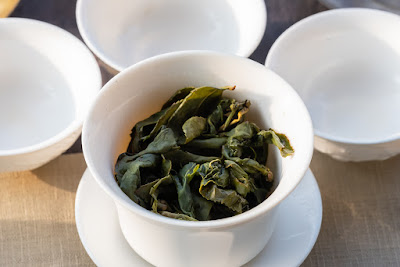 |
| Beauté Orientale impériale de Taiwan |
La synesthésie, c'est le mélange des sens. C'est quand on entend les couleurs, quand on sent les mots, quand on voit des sons... Pour certains, c'est un phénomène neurologique involontaire, mais pour la plupart, c'est une recherche d'harmonie entre les sens. Imaginez écouter de la musique punk pour un repas de Noël: cela ne va pas bien ensemble!
A un mois de cette fête justement, je me suis amusé à prolonger le travail de Denis Raisin Dadre et de son groupe de musique ancienne 'Doulce Mémoire' dans le coffret ci-dessus: la musique secrète de Leonardo da Vinci. Sur le CD, chaque musique de la Renaissance correspond à un tableau particulier de Leonardo. Et le premier tableau marque bien la saison de l'Avent: L'annonciation (1473-75). Il représente l'ange Gabriel annonçant à Marie qu'elle va donner naissance à Jésus:
 |
| L'Annonciation, Musée des offices, Florence |
Ainsi, pour ce tableau, Doulce Mémoire avait l'embarras du choix concernant les Ave Maria, les uns plus somptueux et complexes que les autres. Mais le choix s'est finalement porté sur plusieurs laudes qui sont des chansons religieuse simples et lentes. Elle conviennent parfaitement à l'ambiance relaxante et spirituelle d'un Chaxi, et ces musiques et ce tableau m'ont inspiré le Chaxi suivant:
 |
| Christie's images. Nov. 2017 |
La couleur rouge de la joie est présente sur l'étoffe de l'ange, chez Marie et à l'intérieur de la maison. Je l'ai donc adoptée comme thème et pour mon Chabu.
Ce rouge représente la joie du miracle de la naissance du Christ. Partant de là, je me suis dit que le thé (presque) rouge le plus miraculeux est la
Beauté Orientale. En effet, pour être vraiment bon, ce thé de plaine, d'origine modeste, a besoin des morsure d'insectes minuscules, les petits criquets verts (Jacobiasa Formosana Paoli). Et autre miracle, ses feuilles sèches sont multicolores!
Et pour l'infuser, le choix de ma théière en porcelaine 'blanc de Chine' de De Hua s'est imposé, car c'est dans cette porcelaine qu'on faisait des statues de Guan Yin durant la dynastie Ming (1368-1644). Or, les missionnaires occidentaux utilisaient ces statues pour parler de la Vierge Marie aux Chinois. D'ailleurs, on notera que les gestes des mains de Marie sur le tableau font aussi penser aux gestes des certaines déités du Bouddhisme!
Mes coupes sont également en porcelaine de DeHua, et cela tombe bien, car la couleur ivoire permet de rehausser la couleur de l'infusion des feuilles fortement oxydées!
De plus, avec la théière et mes petites coupes en porcelaine DeHua, j'ai la chance de disposer d'accessoires qui sont pratiquement contemporains de Léonard de Vinci! Leur grâce et leur pureté sont en harmonie avec le sujet, la musique et le thé!
L'annonce est faite dans un jardin de pins et de cyprès. C'est pourquoi j'ai disposé plusieurs bonsai sur mon Chaxi
Sous la théière, j'ai pris une petite assiette porcelaine encore plus ancienne (dynastie Song). Elle est tout ce qu'il y a de plus modeste et simple, comme Marie. Et en même temps, son ancienneté fait écho au fait que la naissance du Sauveur avait été annoncé dans l'Ancien Testament!
Merci Doulce Mémoire pour ce magnifique livret et CD qui allie si bien l'oeuvre de Léonard de Vinci à la musique de son temps. Associer musique et art est une excellente idée, et on peut même s'en inspirer pour son Chaxi!






























































